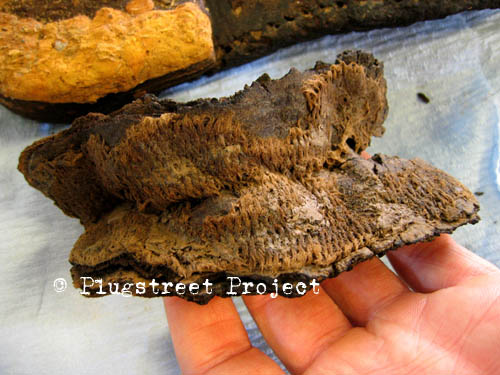The Plugstreet Archaeological Project
Woolen Socks

Woolen Socks.
Angela is the Team's multimedia producer, on site she works as a camera operator, recording all aspects of the dig as it happens.
"Filming on any archaeological site has to be my favorite location, be it Saxon, Roman or 20th Century.
The soldier in the the flax field is not the first set of human remains I have recorded with the lens, the first being much closer to home, in a Saxon cemetery merely yards from my house. The bones and scant possessions of men, women and children who had walked on our village green and perhaps even tilled the soil in the field which is now my garden, a very personal experience.
The remains I filmed in the Saxon cemetery were bare skeletons, the only trace of their humanity a few scant metal items which had survived nine centuries in the ground. The soldier on the battlefield was immediately identifiable as such, with leather hobnail boots on his feet and at his ankles remained traces of his putees. At this point in the excavation, I felt the same way about him as I had the Saxons in their graves, they were people and we were connected by place.
But there is a huge difference between recording a body in a grave, laid there with care by family and friends, and the discovery of a Great War soldier lying where he fell on the battlefield. This man had been killed instantly and remained undisturbed until our team uncovered his boots in the corner of our trench. His friends did not know where he lay, and finding him here would have the curious effect of drawing us very close. His body is not one from ancient history, this man was alive when my Grandparents were born, my Great Uncles fought in the same war in which he died. There is a sense that this is touchable history, we may not yet know his name, but there is every chance that with diligent work, we could find out.
From a film makers point of view the discovery of human remains on the site is a blessing and a curse. On this project we cover the whole site with a very small crew, and the presence of a body brings a shift in our focus; we still have to record progress across the whole site and tell the story of every find, but it is vital that the recovery process is fully documented.
As my team mates began the painstaking process of recovering the remains, I watched through the lens, a privileged position as I see everything in close detail. As the tongue of his boot was lifted carefully from his leg, the image that filled my viewfinder instantly changed my feelings for this man. Perfectly preserved beneath the leather was a good sized piece of woolen sock. Socks which were not vastly different to the woolen socks protecting my own feet and ankles from my tightly laced leather patrol boots, the modern version of the boots he wore.
These woolen socks may have been knitted for him by his mother, sister, wife or girlfriend. Suddenly this man was more than a soldier killed in action, it was a very poignant reminder that he had family and friends ten thousand miles away who would have mourned his loss and waited for news of the location of his burial, longing for a small photo of his grave to arrive in the post. Like so many others, this news would never arrive, they would be left wondering what had become of him. For nine decades he had lain undiscovered and alone, but suddenly it felt as though he had become part of our team, and we would each do our best for him."
Angela Jobson
|
Website and All Material © Copyright MMX - MMXVII - All Rights Reserved The Plugstreet Archaeological Project Website and Multimedia by Middleton House Productions |

